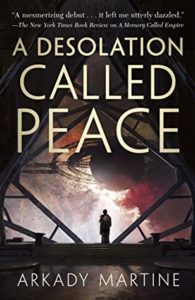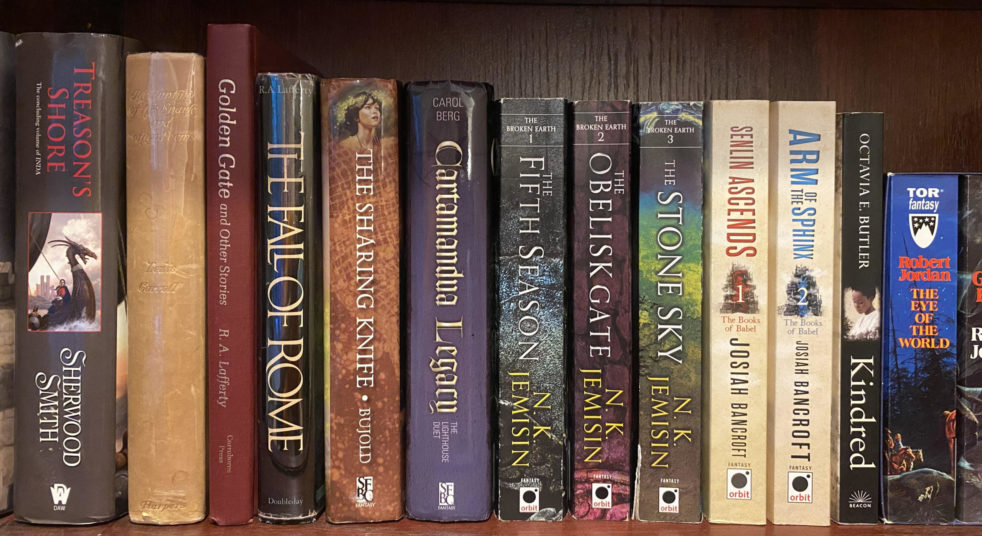
Arkady Martine won the Hugo Award for Best Novel with her debut A Memory Called Empire—a book with some fascinating cultural work to go with a solid-but-unexceptional thriller plot—and has returned to the Best Novel ballot with the second half of the duology: A Desolation Called Peace.
[Note: while I always try to stay away from specific spoilers, it’s impossible to discuss A Desolation Called Peace without inadvertently communicating a general sense of how things stood at the end of the first book. I won’t give details of big events from A Memory Called Empire, but if you’re concerned about learning who is still alive and who is heir to the throne, be warned.]
While A Memory Called Empire was told from the sole perspective of tiny Lsel Station’s ambassador to the ravenous and sprawling empire of Teixcalaan, A Desolation Called Peace expands to four major point-of-view characters, with other minor perspectives scattered throughout the interludes. Joining Ambassador Mahit Dzmare are her former Teixcalaanli cultural liaison Three Seagrass, Teixcalaanli heir Eight Antidote, and Teixcalaanli general Nine Hibiscus. Nine Hibiscus has led six legions of Teixcalaanli forces to the front lines of a war against a mysterious, aggressive, and seemingly unknowable alien power. Her job is to learn enough to defeat them before they bleed even more of the empire’s resources than they already have. Meanwhile, Lsel Station seeks stalemate that will keep them out of the clutches of either power, while back in the heart of the empire, Eight Antidote seeks to understand the tactics being used and the factions within his own government with their own ideas of how to wage war.
The exploration of Teixcalaanli culture in A Desolation Called Peace is no longer new, but it’s still just as good as in its predecessor, and the addition of Teixcalaanli perspective characters allow for a more rounded view of that culture and its challenges—particularly evident in the relationship between Mahit and Three Seagrass. And to my eyes, almost every other element is a step up. Whereas the first book saw Mahit desperately trying to piece together fragments of information about the political environment while being dragged around by the plot, the second starts each perspective character on more stable footing and thus allows them quite a bit more agency. There are still some elements of political thriller and one or two unlikely moves that seem contrived for plot purposes, but the splitting of perspectives allows for more political depth and less rushing from point to point.
And the new perspective characters themselves are excellent. Three Seagrass is about as wildly impulsive as readers of the first book would expect, but is still entertaining; Nine Hibiscus is a well-drawn military leader; and Eight Antidote perfectly balances childhood naïveté with intelligence and a burning desire to do right by his home. Even the shorter perspectives in the interludes added a lot to the book, with one of my favorite passages of the entire novel coming in one Lsel Station Councilor’s assessment of another. And while the first contact plot didn’t really break new ground, it’s a storyline that I always enjoy when handled well, and it allowed for some quality character moments and shrewd assessment of some of Teixcalaan’s hypocrisy.
Overall, it’s a book that’s very well-written, produces multiple well-realized characters, and delivers a solid plot that kept me invested the entire way. There were a couple scenes here and there that didn’t totally hit, and keep this from being an all-timer, but for me it’s a clear step up from the first book, and is thoroughly in the running for best novel I’ve read yet this year.
Recommended if you like: first contact, exploration of language and culture, multiple well-realized perspectives.
Can I use it for Bingo? It’s hard mode for Set in Space, Weird Ecology, and Mental Health.
Overall rating: 18 of Tar Vol’s 20. Five stars on Goodreads.
